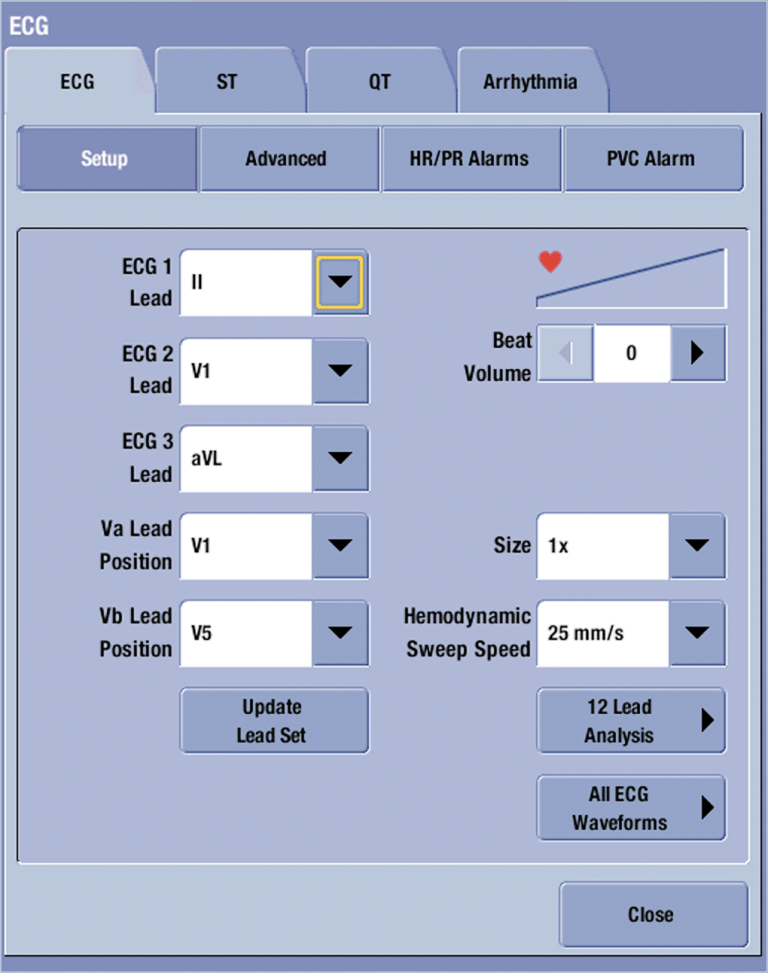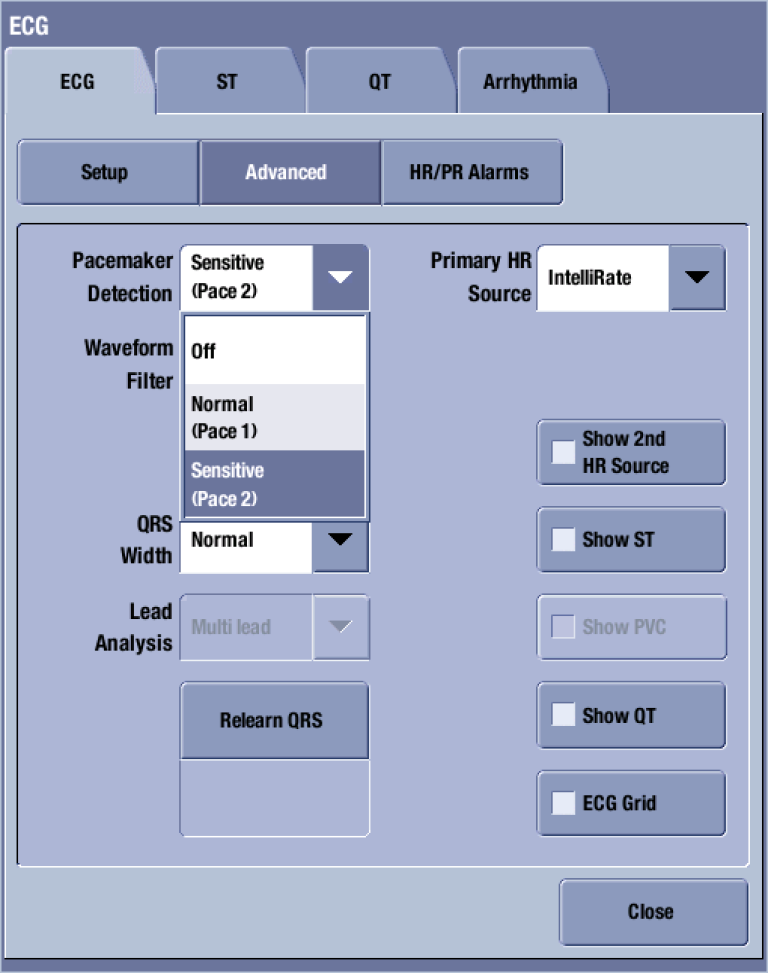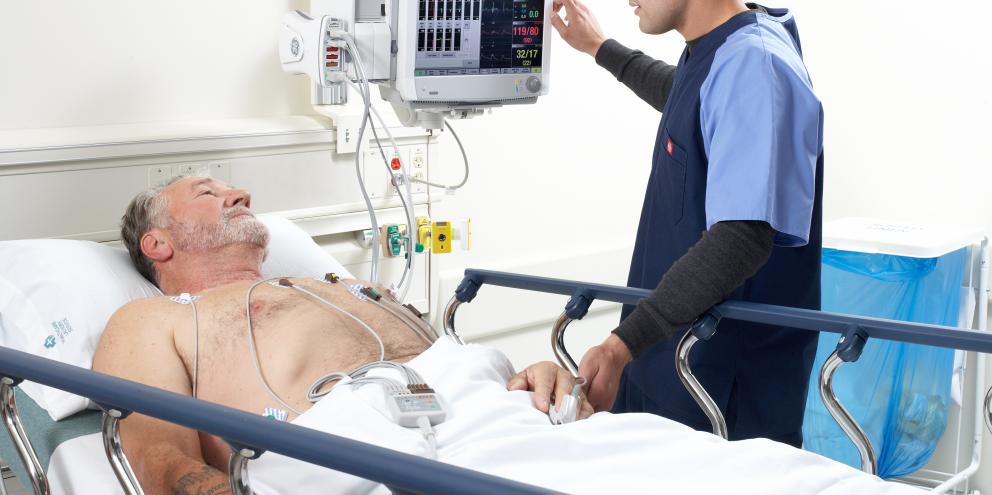Arrhythmia Detection
Arrhythmia means any disturbance or irregularity of the cardiac rhythm. A stable cardiac rhythm is essential to maintain effective contractility and adequate cardiac output. Maintaining an optimal cardiac output leads to adequate organ perfusion and can improve a patient’s clinical outcomes and survival. Therefore, fast and accurate detection of arrhythmias is critical.
Continuous ECG monitoring allows unique views of the electrical activity of the heart from two planes, frontal and horizontal. Viewing the electrical activity of the heart from multiple angles can be very useful to the clinician especially when it applies to arrhythmia detection. Our monitoring system allows the clinician to monitor in multi-lead or single-lead analysis. In general, the more leads used in the arrhythmia analysis leads to a more reliable arrhythmia interpretation.
Multi-Lead Analysis examines ECG leads l, ll, lll and V lead (whether they are displayed or not) to help eliminate false alarms and improve the ability of the system to:
- Detect beats that are not seen in all leads.
- Discriminate artifact that appears in one lead compared to the other leads.
- Provide a smart-lead fail feature, where the failed lead is identified, and, if available, another lead is provided for analysis.
- Non-disturbed ECG arrhythmia analysis even after a lead change.
Sometimes ventricular beats can be more obvious in some of the leads than in others where the changes in morphology are minor. It is also possible that QRS amplitude can be low in one lead and normal in others. Therefore, the sensitivity of the algorithm may increase when more than one lead is used.
The recognition of ventricular beats may be improved by multi-lead monitoring, and the same applies to QRS detection. The decision between normal and ventricular beats may be more reliable when information from more than one lead is available. The EK-Pro arrhythmia algorithm uses I, II, III, and the V/VA lead for arrhythmia detection. The American Heart Association (AHA) has recommended that two or preferably three or more leads should be displayed and monitored simultaneously.* Exceeding the AHA’s minimum recommendation, the distinctive EK-Pro algorithm utilizes four simultaneous leads for analysis.
Even though the multi-lead ECG analysis is preferred and recommended, the algorithm utilizes single lead arrhythmia analysis automatically when 3 lead wired ECG is used. Single lead analyses may also be used with multi-lead monitoring. This is done using manual selection from the user interface.
Single-lead usage can be considered, for example, if majority of the leads are affected with noisy signal or low amplitude QRS resulting in false ECG alarms and incorrect HR readings.
In this case, the user should select the best available lead to be displayed on the monitor and select single lead mode from the user interface.
EK-Pro algorithm, in single lead mode, uses lead II as a default. As an alternative the user is able to choose lead I, III or Va as a source for single lead arrhythmia analysis.
* Mirvis. D. M. et al. Instrumentation and practice standards for electrocardiographic monitoring in special care units. A report for health professionals by a Task Force of the Council on Clinical Cardiology. American Heart Association 79, 464-471 (February 1989).

How are arrhythmias monitored?
The EK-Pro algorithm processing can be represented by three major phases that help determine heart rate, ST segment deviation, and arrhythmia detection:
- Continuous Correlation
- Event measurement and Classification
- Contextual Analysis
Continuous Correlation filters the incoming signal before detecting the incoming events as part of the QRS detection process. Each detected QRS complex is compared to previously detected QRS complexes and the templates are updated accordingly, or a new template is created and the beat is added to the beat list.
Event measurement and classification is a process by which the multi-lead waveform templates used for beat classification and measurement accurately track subtle, progressive changes in beat shapes. With this technology, automated measurements can be made consistently and accurately since waveform artifact is effectively minimized in the waveform templates by using this updating process.
Contextual Analysis allows the algorithm to use information gained from neighboring beats for identifying arrhythmia events. This allows the algorithm to evaluate features and information about the rhythm to make the best possible decision regarding the beat’s origin (e.g., R-R interval, early, late, wide, narrow and run length). A beat is classified as normal, ventricular or artifact and then in conjunction with the decision of the past beat templates, the EK Pro algorithm makes a final determination of the arrhythmia detected and the heart rate.
These features, Continuous Correlation, Incremental Template Updating and Contextual Analysis all work in concert to provide accurate arrhythmia recognition. The EK Pro arrhythmia criteria are listed in the table at the end of this document.
Practical aspects in arrhythmia monitoring
Signal quality
Careful skin preparation and the use of high-quality electrodes are key to ensuring a good ECG signal especially when utilizing arrhythmia monitoring. A good signal helps to ensure accurate arrhythmia detection and helps decrease false and nuisance alarms. If there is artifact in all of the analyzed ECG leads, the EK-Pro algorithm provides a noisy ECG message. If the condition continues the algorithm will provide a “Arrhythmia Paused” or “Arrhy Suspend” message depending on the GE monitor in use. At this point all arrhythmia detection will be suspended until the integrity of the ECG signal is restored.
Relearning the patient’s QRS pattern
Automatic relearning of the patient’s QRS pattern takes place under the following conditions:
- The measurement mode changes between the 3–lead mode and any other lead mode.
- The ECG 1 Lead selection is changed in the 3–lead mode.
- The Va lead selection is changed in the 5– and 6–lead modes.
- The ECG cable is connected (with PSM and PDM modules).
- The Lead Analysis setting is changed from Multi lead to Single lead.
During ECG monitoring, you may need to use the manual Relearn QRS feature when a substantial change in the patient’s ECG pattern has occurred (e.g. due to change of electrodes or electrode locations). The manual relearn of patient’s QRS pattern might correct false arrhythmia alarms and heart rate values. In addition, it restores the ST measurements. Relearning the QRS morphology can be completed manually in the “Advanced” menu of the ECG parameter window. Relearning typically takes 30 seconds or less.
Pacemaker Detection
Pacemaker detection should be activated when patients with pacemakers are monitored. Pacemaker detection is always activated with E-Modules (i.e. E-PSM or E-PRESTN). When utilizing a CARESCAPE™ Patient Data Module (PDM), Tram™ Module or Combination monitoring pacemaker detection may need to be manually activated.
The Patient Data Module and Tram x51 series modules use multi-vector pace detection. The PDM picks 3 channels to detect pacemaker pulse amplitude. Here are some additional guidelines for monitoring pacemaker patients when using one of these modules.
- When using the 5- or 6-leadwire patient cables with all the electrodes attached, pace detection occurs on three ECG leads simultaneously.
- Channels I, II and V1 are used for pace detection as a default, when 5 or 6 lead wire cable is connected. If these leads are noisy or not available, multi-vector pace detection switches to better signal or next available leads.
- Pace detection switches to single-lead automatically when a 3-leadwire patient cable is used.
Pace detection in combination monitoring or telemetry utilizes multi-vector pace detection. The Apex Pro™ telemetry system picks 2 channels to detect pacemaker pulse amplitude. Lead II and Va are used for pace detection as a default, when 5- or 6- lead wire cable is connected to the transmitter.

ECG Arrhythmia alarms
In GE monitors there are three arrhythmia analysis modes: Off, Lethal and Full. The Lethal mode is the standard, where the Off and Full are optional choices. The Lethal mode detects asystole, ventricular fibrillation/ventricular tachycardia and ventricular tachycardia. Please note, that bradycardia is considered as lethal arrhythmia in neonatal mode only when using Tram module.
Different generations of EK-Pro algorithms are used in CARESCAPE Bx50 v2 monitors, Solar™ monitors, Dash™ monitors, ApexPro telemetry and CARESCAPE Telemetry systems:
- CARESCAPE Bx50 monitors with software v2 in conjunction with PDM and PSM modules are utilizing EK-Pro v13 algorithm.
- If Tram module (CARESCAPE B850 only) or telemetry in combo mode is used with CARESCAPE Monitors, the ECG algorithm in use is EK-Pro v11.
- Solar Monitors, Dash monitors, Transport Pro™ and Telemetry systems utilize EK-Pro v11 algorithm.
The details of arrhythmia alarms criteria are described in the following table. Please see pdf file below!
For the most current arrhythmia calls, please consult the user manual specific to
your current monitor for the details.
Additional resources
For white papers, guides and other instructive materials about our clinical measurements, technologies and applications, please visit http://clinicalview.gehealthcare.com







